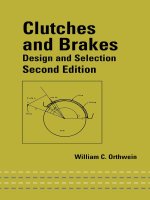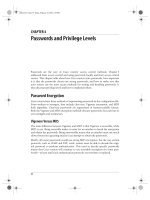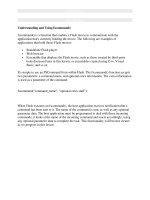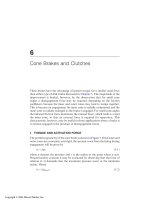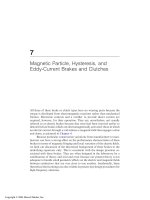Tài liệu Clutches and brakes design and selection P10 pdf
Bạn đang xem bản rút gọn của tài liệu. Xem và tải ngay bản đầy đủ của tài liệu tại đây (475.91 KB, 28 trang )
10
Friction Drives with Clutch Capability
Friction drives that also have clutch capabilities are attractive because they
are relatively simple and inexpensive. However, they have been inherently
limited to relatively low-power applications because of their dependence upon
a coefficient of friction that is usually less than 0.6 between the contacting
materials. A friction drive was used in an early automobile, but it was
discontinued because of its power limitation.
Friction drives recently have been given new life with the development
of elastohydrodynamic fluids that become solid under pressure and can
change from solid to liquid and back within microseconds. The fluids provide
an effective friction coefficient that may be 1.0 or greater as long as the
tangential forces impose a shear stress that is less than the ultimate shear stress
of the solid-state form of the elastohydrodynamic fluid. Hence, these drives,
which feature metal-to-fluid/solid-to-metal contact, can transmit sufficient
power to find industrial and automotive applications that benefit from their
ability to easily and simply provide continuously variable speeds. At this time
they are relatively expensive because of the structure needed to support the
large contact forces that induce the fluid-to-solid transformation. They are
presently known as traction drives. At this time, however, no known traction
drives in production include a clutch capability; consequently they will not be
included in this chapter.
Several formulas presented in this chapter may be written in nondimen-
sional form for three reasons: (1) the nondimensional form indicates the
relative significance of the ratios selected; (2) it allows drive designs to easily
be scaled up or down for various applications; and (3) it allows any consistent
Copyright © 2004 Marcel Dekker, Inc.
setofunitstobeusedforeachratio,andtheresultingratiosareindependent
oftheunitsused.
Relativelybroadcurvesareshowninthefollowingcomputer-generated
graphsforeasyreadingtoshowcharacteristicbehaviorandtoprovide
contrastagainstthegridlines.Associatedroutines,suchasMathcadTrace,
appeartoreadthemfromtheoriginatingdata,therebyeliminatingtheread-
ingerrorsassociatedwithtracewidths.
I.BELTDRIVES
Equipmentusingnonmetallicbeltdrivesmayincludetheclutchcapabilityby
mountingthemotor(becauseitisusuallysmallerthanthedrivenmachine)
eitheruponahingedbaseoruponaslidingbasefittedwithaleveroralinkage
thatpermitsthemotortobemovedtoandfromthedrivenmachineinorder
toapplyandrelievethebelttensionandtherebygiveclutching(applyingbelt
tension)anddeclutching(relievingbelttension)capability.
Thesedesignseliminatetheneedforamechanicalclutch.Theirsim-
plicityisachieved,however,attheriskofintroducingthepossibilitythat
frictionalheatingofthebeltduringidling,whenthebelt(orbelts)mayreston
themotor’srotatingsheave(pulley).Thatmaygenerateenoughheattocause
beltingmaterialstoslowlyshrink.Thisreductioninthecenterdistance
betweenthedrivinganddrivenpulleys,orsheaves,maybegreatenoughto
causeanunintendedre-engagementofthemotorandthedrivenmachine.It
mayalsoinhibittheirdisengagement.Consequently,somebeltmanufacturers
producebeltsthatresistshrinkageduetoheatingforuseintheseclutching
anddeclutchingapplications.
Torquecapabilityforthesedrivesisaseparatecalculationtobe
performedaccordingtotheproceduresgivenbythebeltmanufacturers.
Therefore,itwillnotbeconsideredinthefollowingdiscussion.
A.HingedBase
Atfirstglanceitmayappearthatmovingamotorbymountingiteitherona
hingedbaseoronaslidingbaseissosimplethatnoanalysisisnecessary.An
analysis,however,doesbringforthseveralconsiderationsthatmaybemissed
inselectingthedimensionsofthebaseplate,inlocatingthepositionofthe
baseplatehinge,orindesigningthelinkagefortheslidingbaseplate.
Twosimilar,butdistinct,mountingdesignsforhingedbaseswillbe
considered.Intheseconfigurationsitistheweightofthemotoralonethat
providesthebelttension.ThetensionvectorshowninFigure1(a)and(b)
acting at the center of the motor shaft represents the sum of the tension acting
through the upper and lower belts.
Chapter 10230
Copyright © 2004 Marcel Dekker, Inc.
Analysisofthefirstofthetwoisbasedupontheconfigurationshownin
Figure1(a).UpontakingmomentsaboutthehingepointPinFigure1(a)we
have
WacosuÀbsinuðÞ¼TasinuþBðÞþbcosuþBðÞ½
Afterlettings=b/a,thisequationmaybewrittenas
T
W
¼
cosuÀssinu
sinuþfðÞþscosuþfðÞ
ð1-1Þ
whereuispositiveintheclockwisedirectionfromahorizontalplanethrough
pointPandfispositivecounterclockwisefromahorizontalplaneeither
throughorparalleltothemotor’saxisofsymmetry.
Figure2(a)and(b)showthattheweight-to-tensionratioW/T=1/(T/
W)decreaseswithangleuwhenf=0.Inotherwords,sinceWisconstant,a
decreasingW/TratiomeansthattensionTincreasesasudecreasesuntilu
becomesnegativeenoughforthetensionvectorTtopassthroughthehinge
linethatpassesthroughpointP.ThatoccursatthepointwhereW/T=0on
thetwolowercurvesinFigure2(a).TensionTgoestoinfinityinFigure2(b)at
thosepointsthatareatapproximatelyu=À30.8jfors=0.6onthemiddle
curveandatapproximatelyu=À16.6jfors=0.3onthelowercurve,as
determinedeitherbyusingMathcad’sxÀyTracefeatureorbyinterpolation.
BycomparingthecurvesinFigure2(a)itisevidentthattheW/Tratioalso
increasesassincreasesforf=0andu=20j.
F
IGURE
1Hingedbase,beltdrive.
Friction Drives with Clutch Capability 231
Copyright © 2004 Marcel Dekker, Inc.
UponturningtoFigure2(b)andrecallingthatnonmetallicbeltsunder
tensionstretchovertime,itisclearthatwheneverthesebeltsareused,the
tensiononthemwillincreaseastheangleudecreasesduetothebelt’s
stretching.Hence,themotormustbemovedperiodicallyifthetensionisto
remainwithinnarrowlimits.
TherapidincreaseintensionfornegativevaluesofuinFigure2(b)
emphasizesthattheconfigurationshowninFigure1(b)shouldbeavoided
wheneverpossible.
Asecondhingedconfiguration,showninFigure3,differsfromthefirst
becausethemotorbasemustbesupportedintheoperating,orclutched,
positionandthenloweredfordeclutching.AcamisshowninFigure3asone
ofseveralmeansforloweringthemotorfordeclutching.Someprovisionmust
bemade,however,tomaintainbelttensionasthebeltstretches.
Upontakingmomentsaboutthehingeandlettinglrepresentthe
distancefromthehingetothesupportpoint(fromthehingetothecontact
betweenthecamandbaseplateinFigure3)wehavethat
Fl¼WacosuþbsinuðÞþTasinuþfðÞÀbcosuþfðÞ½ð1-2Þ
Let
D¼
a
l
K¼
W
T
~¼
b
a
F
IGURE
2Variationofweight-to-tensionW/Tratioandtension-to-weightratioT/W
with angle. (a) Plot of W/T, in which f = 0 for all curves; curve 1, s = 0.8; curve 2, s
= 0.6; curve 3, s = 0.3. (b) Plot of T/W, in which f = 0 for all curves; curve 1, s = 0.3;
curve 2, s = 0.6; curve 3, s = 0.8.
Chapter 10232
Copyright © 2004 Marcel Dekker, Inc.
Soequation(1-2)maybewrittenindimensionlessformas
F
T
¼DsinuþfðÞÀ~cosuþfðÞþLcosuþ~sinuðÞ½ð1-3Þ
B.SlidingBase
Athirdmechanismforclutchinganddeclutchinginvolvesplacingthemotor
onaslidingbase,asshownintheupperdrawinginFigure4,inwhichthe
motorbasemaybebothmovedbackandforthandlockedinplacebyapairof
linkages,oneoneachsideoftheslidingbase,asshowninthelowerdrawingin
Figure4.Itislockedinplacebymovingthelinkagetoastopbelowtheplane
oftheslide,aspicturedinthelowerdrawinginFigure4.Thisgeometry
providesafeaturenotfoundintheprevioustwodesigns:adetenteffectonthe
clutchinganddeclutchingforceinwhichthelinksaandrwillsnapintothe
clutched,orengaged,positionafteraforcemaximumisreached.Thisoccurs
becausethebeltisstretchedslightlybeyonditsoperatinglengthasthemotor
basemovesbackandforthfromthedeclutchedtotheclutchedpositionofthe
base.
Bysummingforcesinthehorizontaldirectionactingontheslideupon
whichthemotorismounted,andassumingthattheslideislubricatedsothat
thatthesmallfrictionforcebetweenslidingsurfacesmaybeignoredincom-
F
IGURE
3Secondhingedbaseconfiguration,beltdrive.
Friction Drives with Clutch Capability 233
Copyright © 2004 Marcel Dekker, Inc.
parison with the belt tension, we find from Figure 4 that the force F
a
that acts
through link a is related to the horizontal force H acting on the base according
to
F
a
cos k ¼ H ð1-4Þ
where from Figure 4 we also find that
H ¼ T cos a ð1-5Þ
The change in angle a as the slide moves is assumed to be small enough
relative to changes in angles u and E that it may be ignored. Upon taking
F
IGURE
4 Upper drawing: enlarged sketch of sliding motor mount for a belt drive.
Lower drawing: linkage geometry.
Chapter 10234
Copyright © 2004 Marcel Dekker, Inc.
momentsaboutpivotBinFigure4(b)weobtain
F
o
l ¼ F
a
r sin y ð1-6Þ
where
y ¼ h À E in the clutched; or operating; position
y ¼ u À E during de-clutching;
ð1-7Þ
when belt tension is relaxed and where F
o
is the force that either the operator
or the actuator exerts at the left-hand end of link r. From the law of sines and
the geometry in Figure 4, E is related to u according to
a sin k ¼ r sin u in the de-clutched position
a sin k ¼ r sin h in the clutched ðoperatingÞ position:
ð1-8Þ
After substituting for y from the second of equation (1-7) into equation (1-6)
and then solving for g from the first of equations (1-8), equation (1-6) may be
rewritten as
F
o
l ¼ F
a
r sin u À sin
À1
r
a
sin u
hi
ð1-9Þ
Moving the motor away from the driven machine to begin declutching causes
the belt to stretch an amount Dc. The corresponding change in length b is
given by
Db ¼ Dc cos a ð1-10Þ
according to the geometry shown in Figure 4.
The force acting on the sliding base during the initial declutching
motion as the linkage moves to increase the distance b may be written as
H þ DH ¼ T þ k DcðÞcos a ¼ T cos a þ k Db ð1-11Þ
upon using relation (1-10). In equation (1-11), constant k is the spring for the
belt, which is defined by k = force/elongation, hence the force required to
strech the belt, which is given by k Dc.
Length Db may be calculated from the law of cosines, by which the
length b may be written in terms of the lengths of links r, a and included angle
y as
b
2
¼ r
2
þ a
2
À 2ar cos y
Substitution from y = h À E and from the first of equations (1-7) gives
b
o
¼ r
2
þ a
2
À 2ar cos h À sin
À1
r=aðÞsin hðÞ
ÂÃÈÉ
1=2
Friction Drives with Clutch Capability 235
Copyright © 2004 Marcel Dekker, Inc.
atthelocked,orclutched,position,andsubstitutionofy=hÀEfromthe
secondofequations(1-7)gives
b¼r
2
þa
2
À2arcosuÀsin
À1
r=aðÞsinuðÞ
ÂÃÈÉ
1=2
RecallthatuVhduringdeclutching,andnotethatbothhanduare
positiveinthecounterclockwisedirectionfromthehorizontalplane.
Bysubtractingbfromb
o
wehave
Db¼r
2
þa
2
À2arcoshÀsin
À1
r
a
sinh
hino
1=2
Àr
2
þa
2
À2arcosusin
À1
r
a
sinu
hino
1=2
ð1-12Þ
whichmayberewrittenas
Db¼a1þG
2
À2GcoshÀsin
À1
GsinhðÞ
ÂÃÈÉ
1=2
Àa1þG
2
À2Gcosusin
À1
GsinuðÞ
ÂÃÈÉ
1=2
ð1-15Þ
whereG=r/aandhisthelimitingvalueofuattheoperatingpositionwhen
linkarestsagainstastopasshowninFigure4(b).Preparatorytothenext
substitution, note that the belt’s effective spring constant k may be written as k
= T/q, where q is the elongation of the belt due to tension T.
Substitution from equation (1-12) into equation (1-11) and then into
equations (1-4) and (1-9) yields
F
o
T
¼ n cos a þ g 1 þ U
2
À 2U cos h À sin
À1
U sin hðÞ
ÀÁÂÃ
1=2
n
À g 1 þ U
2
À 2U cos u À sin
À1
U sin uðÞ
ÀÁÂÃ
1=2
gð1-13Þ
Â
sin u À sin
À1
U sin uðÞ
ÂÃ
cos sin
À1
U sin uðÞ
ÂÃ
upon substituting for ka/T according to ka/T = a/q. Parameters g and n are
defined by
g ¼
a
e
n ¼
r
l
U ¼
r
a
ð1-14Þ
By measuring angles in the counterclockwise direction, the force F
o
will
be positive upward when links a and r are below the horizontal and negative
when they are above, indicative of the directions of the initial force to declutch
and of the force necessary to keep the linkage in equilibrium when u goes
negative as belt tension is relieved.
Examination of equation (1-13) reveals that n is a multiplicative
constant that decreases the belt tension with increasing lever arm l relative
to link r and that g is a parameter that introduces the effect of belt elasticity.
Chapter 10236
Copyright © 2004 Marcel Dekker, Inc.
TheplotofF
o
/TasafunctionofUinFigure5showsthatthereisan
optimumvalueofUthatgivesthelargestdetenteffect.WhenU=0thereis
obviouslynobeltstretchingbecauser=0forallfinitel.WhenU=1,lengthr
isthesameaslengtha,whichimpliesthattheyhavecommonpivotpoints,
againmakingbeltstretchimpossible.Noticethatalthoughthemaximain
Figure5varyslightlywithu,theylieinthevicinityofU=0.3forthe
parametersshown.
ByplottingF
o
/TasafunctionofuinFigure6wefindthatthe
maximumliesatatorcloseto12jforh=20j.Itisalsoclearthatforthese
valuesofn,g,andhthatthechoiceofh(hzu)isimportantifadetenteffect
istobehad.
II.FRICTIONWHEELDRIVE
Thistypeofdrive,showninFigure7,providesbothclutchcapabilityand
speedvariationfunctionsinonepairofdiscs.Thistypeoffrictiondriveis
limitedtorelativelylow-powerapplications,suchasthesmallerridinglawn-
mowersforresidentialuse,becausepowertransferbetweendiscsislimitedby
thecontactforce,thefrictioncoefficient,andtheshearstrengthofthetireon
F
IGURE
5Variationoftheratioofoperatorforcetobelttension,F
o
/T, with U. For
all curves, n =1,g = 1000, a =14j, and h =20j. Angles u are as follows: curve 1,
6j; curve 2, 9j; curve 3, 12j; curve 4, 15j, and curve 5, 20j.
Friction Drives with Clutch Capability 237
Copyright © 2004 Marcel Dekker, Inc.
F
IGURE
7 Friction drive.
F
IGURE
6 Dependence of the ratio of operator force to belt tension, F
o
/T, on angle
u. For all curves, n = 0.001, U = 0.336, g = 1. Curve 1, h =20j; curve 2, h =15j;
curve 3, h =10j; and curve 4, h =5j.
Chapter 10238
Copyright © 2004 Marcel Dekker, Inc.
thedrivendisc.Itisaninexpensivealternatetoaclutch,bevelgears,anda
transmission.
FromFigure7itfollowsthatthemaximuminputtorqueisgivenby
T
0
=ANr, which is limited by the normal force N and the coefficient of friction
A between the disks. If we let N
0
and N
1
represent the angular velocities of the
small driver disk and the large driven disk, respectively, it is evident from
Figure 7 that the output angular velocity and the maximum output torque T
1
will be given by the following relations if no power is lost due to slippage
between the disks; namely,
N
1
¼ N
0
r
R
and T
1
¼ T
0
R
r
¼ ANR: ð2-1Þ
Two possible modes of torque transfer appear possible. In one there
may be momentary no-slip contact between the driving and driven discs at
some point at or between radii R À w/2 and R + w/2, where w is the
width of the tire on the driven disc. Since the location of this point may
change from moment to moment, the driven angular velocity may vary
between
N
1À
¼ N
0
R À w=2
r
and N
1þ
¼ N
0
R À w=2
r
ð2-2Þ
Consequently, the tire may slide over the driver disc except at some point
along a line in the contact region. In the other possible mode there may be
slip everywhere over the contact region. In the first case, the rotational
speed of the driven disc may be found from equation (2-1), and in the
second case it will not exceed that given by equation (2-1). Torque transfer
may be calculated using the dynamic rather than the static coefficient of
friction for the materials involved.
Next, let T
0
denote the torque supplied by the driver disk and T
1
denote
the torque transmitted from the driven disk. In terms of the magnitude of the
tangential forces f
max
or f
min
that act between the surface of the driver disk and
the tire of the driven disk at their region of contact, we have
f
max
R À
w
2
¼ T
0
ð2-3Þ
f
min
R À
w
2
¼ T
0
where AN z f
max
>f
min
, in which A is the dynamic coefficient of friction for the
materials involved and N is the normal force that presses the driven wheel
against the surface of the driving disc. Thus, if the driven wheel is driven at its
outer edge,
T
1min
¼ rf
min
¼ T
0
r
R þ w=2
ð2-4Þ
Friction Drives with Clutch Capability 239
Copyright © 2004 Marcel Dekker, Inc.
